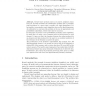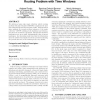1529 search results - page 5 / 306 » Search Space Analysis of the Linear Ordering Problem |
STOC
2003
ACM
14 years 7 months ago
2003
ACM
Many algorithms and data structures employing hashing have been analyzed under the uniform hashing assumption, i.e., the assumption that hash functions behave like truly random fu...
MICAI
2005
Springer
14 years 1 months ago
2005
Springer
Abstract. Kernel based methods (such as k-nearest neighbors classifiers) for AI tasks translate the classification problem into a proximity search problem, in a space that is usu...
GECCO
2009
Springer
14 years 2 months ago
2009
Springer
We address a large scale waste collection vehicle routing problem with time windows (VRPTW) complicated by multiple disposal trips and drivers lunch breaks. A fitness search spac...
JSAT
2008
13 years 7 months ago
2008
We analyze, in this work, the performance of a recently introduced weighted Max-SAT solver, Clone, in the Max-SAT evaluation 2007. Clone utilizes a novel bound computation based o...
EVOW
2010
Springer
14 years 2 months ago
2010
Springer
Abstract. The fitness distance correlation (FDC) as a measure for problem difficulty was first introduced by Forrest and Jones. It was applied to many binary coded problems. This...


